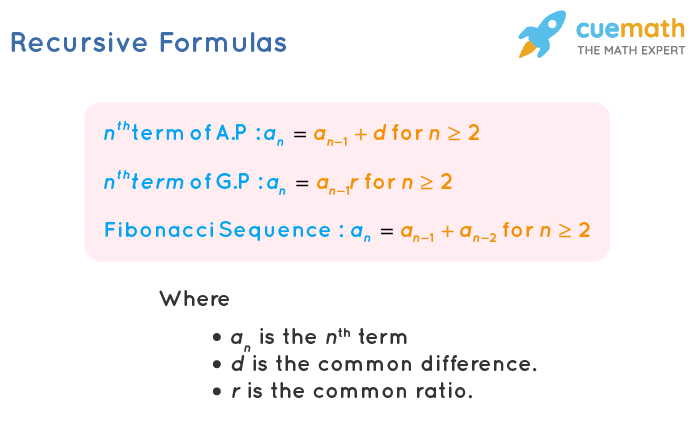Recursive Formula
Before going to learn the recursive formula, let us recall what is a recursive function. A recursive function is a function that defines each term of a sequence using a previous term that is known, i.e. where the next term is dependent on one or more known previous term(s). A recursive function h(x) can be written as:
h(x) = a0 h(0) + a1h(1) + ....... + ax-1 h(x-1) where ai ≥ 0 and at least one of the ai > 0
Let us learn the recursive formulas in the following section.
What Are Recursive Formulas?
A recursive formula refers to a formula that defines each term of a sequence using the preceding term(s). The recursive formulas define the following parameters:
- The first term of the sequence
- The pattern rule to get any term from its previous term

Recursive Formulas
The following are the recursive formulas for different kinds of sequences.
Recursive Formula for Arithmetic Sequence
The recursive formula to find the nth term of an arithmetic sequence is:
an = an-1 + d for n ≥ 2
where
- an is the nth term of a A.P.
- d is the common difference.
Recursive Formula for Geometric Sequence
The recursive formula to find the nth term of a geometric sequence is:
an = an-1 r for n ≥ 2
where
- an is the nth term of a G.P.
- r is the common ratio.
Recursive Formula for Fibonacci Sequence
The recursive formula to find the nth term of a Fibonacci sequence is:
an = an-1 + an-2 for n ≥ 2, where
- a0 = 1 and
- a1 = 1
where an is the nth term of the sequence.
Let us see the applications of the recursive formulas in the following section.

Examples Using Recursive Rule
Example 1: The recursive formula of a function is, f(x) = 5 f(x-2) + 3, find the value of f(8). Given that f(0) = 0.
Solution:
f(8) = 5 f(6) + 3
f(6) = 5 f(4) + 3
f(4) = 5 f(2) + 3
It is given that f(0) = 0. Thus,
f(2) = 5 f(0) + 3 = 3
f(4) = 5 × 3 + 3 = 18
f(6) = 5 × 18 + 3 = 93
f(8) = 5 × 93 + 3 = 468
Answer: The value of f(8) is 468.
Example 2: Find the recursive formula for the following arithmetic sequence: 1, 6, 11, 16 .....
Solution:
Let an be the nth term of the series and d be the common difference.
d = a2 - a1 = 6 - 1 = 5
an = an-1 + 5
Answer: The recursive formula for this sequence is an = an-1 + 5
Example 3: The 13th and 14th terms of the Fibonacci sequence are 144 and 233 respectively. Find the 15th term.
Solution:
Using the recursive formula for the Fibonacci sequence,
15th term is the sum of 13th term and 14th term.
15th term = 13th term + 14th term
= 144 + 233
= 377
Answer: The 15th term of the Fibonacci sequence is 377.
FAQs on Recursive Formula
What is the Recursive Formula in Math?
A recursive formula is a formula that defines any term of a sequence in terms of its preceding term(s). For example:
- The recursive formula of an arithmetic sequence is, an = an-1 + d
- The recursive formula of a geometric sequence is, an = an-1r
Here, an represents the nth term and an-1 represents the (n-1)th term.
How to Find the Recursive Formula for an Arithmetic Sequence?
To find a recursive sequence in which terms are defined using one or more previous terms which are given.
- Step 1: Identify the nth term (an) of an arithmetic sequence and the common difference, d,
- Step 2: Put the values in the formula, an+1 = an + d to find the (n+1)th term to find the successive terms.
What is the Recursive Rule For the Fibonacci series?
The Fibonacci series is characterized as the series in which each number is the sum of two numbers preceding it in the sequence. Thus, the Fibonacci formula is given as, Fn = F(n-1) + F(n-2), where n > 1.
What Is an in Recursive Formula?
In any recursive formula, an refers to the nth term in the sequence, which can be found using the recursive formulas:
- nth term of A.P: an = an-1 + d for n ≥ 2
- nth term of G.P: an = an-1 for n ≥ 2
- nth term of a Fibonacci Sequence: an = an-1 + an-2 for n ≥ 2
What is the Difference Between Recursive and Explicit Formulas?
The recursive formula is used to find a term of a sequence when its previous term is known. The explicit formula is used to find the term of a sequence irrespective of information about its previous term. For example:
- The recursive formula to find the nth term of AP is: an = an-1 + d
- The explicit formula to find the nth term of AP is, an = a + (n - 1) d
visual curriculum